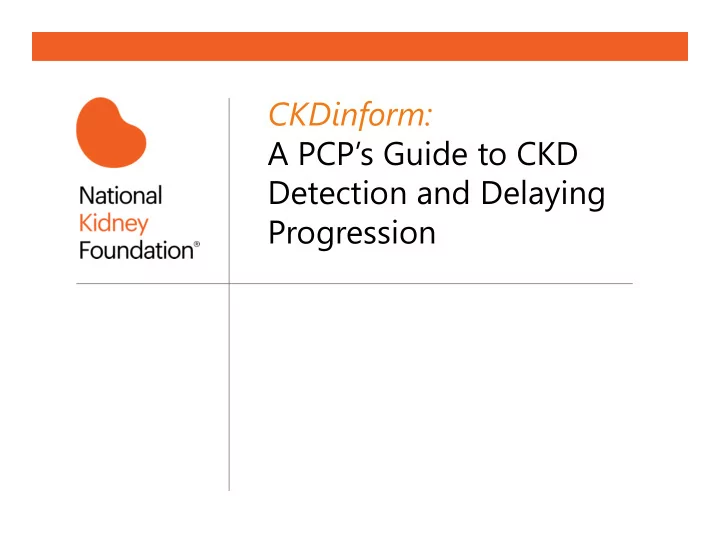

���������� A PCP’s Guide to CKD Detection and Delaying Progression
Learning Objectives • Describe suitable screening tools, such as GFR and ACR, for proper utilization in clinical practice related to the diagnosis and monitoring of CKD. • Define and classify CKD, based on GFR and albuminuria categories, in order to guide appropriate treatment approaches. • Recognize evidence&based management strategies that will help delay CKD progression in at&risk patients and improve outcomes.
Classification of CKD Based on GFR and Albuminuria Categories: “Heat Map” Albuminuria categories Description and range CKD is classified based on: A1 A2 A3 • Cause (C) Normal to • GFR (G) Moderately Severely mildly • Albuminuria (A) increased increased increased ≥ 300 mg/g 30-299 mg/g <30 mg/g ≥ 30 3-29 <3 mg/mmol mg/mmol mg/mmol Monitor Refer* Normal or ≥ 90 1 if CKD G1 high 1 2 GFR categories (ml/min/1.73 2 ) Monitor Refer* Mildly 1 if CKD G2 60-89 Description and range decreased 1 2 Mildly to Monitor Monitor Refer G3a moderately 45-59 1 2 3 decreased Moderately to Monitor Monitor Refer G3b severely 30-44 2 3 3 decreased Refer* Refer* Refer Severely G3 15-29 decreased 3 3 4+ Refer Refer Refer G5 Kidney failure <15 4+ 4+ 4+ Colors: Represents the risk for progression, morbidity and mortality by color from best to worst. Green: low risk (if no other markers of kidney disease, no CKD); Yellow: moderately increased risk; Orange: high risk; Red, very high risk. Numbers: Represent a recommendation for the number of times per year the patient should be monitored. Refer: Indicates that nephrology referral and services are recommended. *Referring clinicians may wish to discuss with their nephrology service depending on local arrangements regarding monitoring or referral. Adapted from Kidney Disease: Improving Global Outcomes (KDIGO) CKD Work Group. Kidney Int Suppls . 2013;3:1-150.
eGFR, SCr Comparison Age Weight in lbs Sex Race SCr eGFR ml/ eGFR Height in Ft/in mg/dl min Adj for BMI per CKD-EPI 25 285 M AA 1.6 68 97 6’ 49 180 F Hispanic 1.6 38 41 5’4’’ 67 155 M Asian 1.6 44 46 5’8’’ 92 98 F Caucasian 1.6 28 22 5’1’’
Average Measured GFR by Age in People Without CKD Coresh J, et al. ����������������� 2003;41(1):1&12.
Clinical Evaluation of Patients with CKD • Blood pressure • HbA1c • Serum creatinine Use a GFR estimating equation or clearance measurement; don’t rely on o serum creatinine concentration alone. Be attentive to changes in creatinine over time&&even in “normal” range. o • Urinalysis Urine sediment o Spot urine for protein&to&creatinine or albumin&to&creatinine ratio. o • Albuminuria/Proteinuria • Electrolytes, blood glucose, CBC
Clinical Evaluation of Patients with CKD • Depending on stage: albumin, phosphate, calcium, iPTH • Renal imaging • Depending on age and H&P o Light chain assay, serum or urine protein electrophoresis (SPEP , UPEP) o HIV, HCV, HBV tests o Complements, other serologies—limited role unless specific reason
Definitions: Albuminuria and Proteinuria • Normal Albuminuria o Albumin&to&creatinine ratio <30 mg/g creatinine • Moderately Increased Albuminuria o Albumin&to&creatinine ratio 30&300 mg/g creatinine o 24&hour urine albumin 30&300 mg/d • Severely Increased Albuminuria o Albumin&to&creatinine ratio >300 mg albumin/g creatinine o 24&hour urine albumin >300 mg/d • Proteinuria o (+) urine dipstick at >30 mg/dl >200 mg protein/g creatinine o o 24&hour urine protein >300 mg/d
Blood Pressure and CKD Progression • Control of BP more important than exactly which agents are used. o Avoidance of side&effects is important. • With proteinuria: diuretic + ACEi or ARB. • No proteinuria: no clear drug preference o ACEi or ARB ok to use. Fujisaki K, et al. Impact of combined losartan/hydrochlorothiazide on proteinuria in patients with CKD and hypertension. Hypertens Res . 2014;37:993-998.
Goals for Renoprotection • Target blood pressure in non&dialysis CKD: 1 o ACR <30 mg/g: ≤140/90 mm Hg o ACR 30&300 mg/g: ≤130/80 mm Hg* o ACR >300 mg/g: ≤130/80 mm Hg o Individualize targets and agents according to age, coexistent CVD, and other comorbidities. • Avoid ACEi and ARB in combination. 3,4 o Risk of adverse events (impaired kidney function, hyperkalemia). *Reasonable to select a goal of 140/90 mm Hg, especially for moderate albuminuria (ACR 30&300 mg/g.) 2 1) Kidney Disease: Improving Global Outcomes (KDIGO) Blood Pressure Work Group. ���������������� . (2012);2:341&342. 2) KDOQI Commentary on KDIGO Blood Pressure Guidelines. ��������������� . 2013;62:201&213. 3) Kunz R, et al. �������������� . 2008;148:30&48. 4) Mann J, et al. ONTARGET study. ������ . 2008;372:547&553.
���������������������� • Hyperglycemia is a fundamental cause of vascular complications, including CKD. • Poor glycemic control has been associated with albuminuria in type 2 diabetes. • Risk of hypoglycemia increases as kidney function becomes impaired. • Declining kidney function may necessitate changes to diabetes medications and renally cleared drugs. • Target HbA1c ~7.0%. o Can be extended above 7.0% with comorbidities or limited life expectancy, and risk of hypoglycemia. ����������������������������������������� ��������������� ������������������
Other Goals of CKD Management • Limit sodium intake to <90 mmol (2 gm sodium; or 5 gm sodium chloride or salt) per day. • CVD management: lipids, ASA (secondary prevention), etc.
Complications of Kidney Failure Start in Stage 3 and Progress Fluid Overload Acid Base Imbalance Water Overload Acidic Blood Malnutrition Electrolyte Abnormalities Kidney Failure Bone Disease Hypertension Brittle bones Cardiac Disease and fractures Vascular Disease Anemia/blood loss Decrease production of red blood cells
Education and Counseling • Ethical, psychological, and social care (e.g., social bereavement, depression, anxiety). • Dietary counseling and education on other lifestyle modifications (e.g., exercise, smoking cessation). • Involve the patient, family and children if possible. • Offer literature in both traditional and interactive formats. • Use educational materials written in the patient’s language. • Assess the need for low&level reading materials. • Use internet resources and smartphone apps as appropriate. • Use visual aids such as handouts, drawings, CDs, and DVDs. • Involve other health care professionals in educating patients/families. • Be consistent in the information provided.
Recommend
More recommend